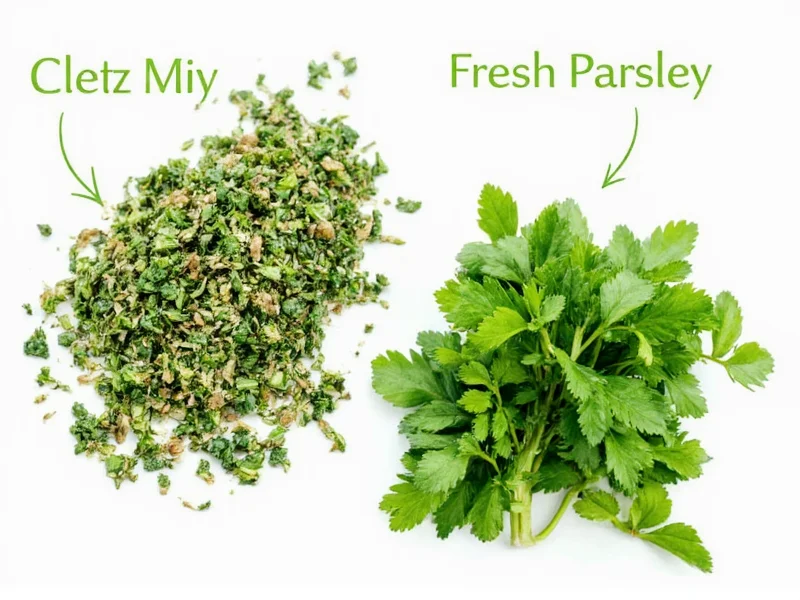Understanding herb conversions is essential for achieving perfect flavor in your cooking. When substituting dried parsley for fresh (or vice versa), getting the measurements right makes the difference between a well-balanced dish and one that's either bland or overpowering.
Why Dried and Fresh Parsley Have Different Measurements
Dried parsley contains no moisture, making its flavor compounds more concentrated than fresh parsley. During the drying process, parsley loses approximately 80-90% of its water content, leaving behind intensified flavor compounds. This concentration explains why you need less dried parsley than fresh to achieve similar flavor intensity in recipes.
Precise Dried to Fresh Parsley Conversion Chart
| Dried Parsley | Fresh Parsley Equivalent | Volume Measurement |
|---|---|---|
| ¼ teaspoon | ¾ teaspoon | Chopped fresh leaves |
| ½ teaspoon | 1½ teaspoons | Chopped fresh leaves |
| 1 teaspoon | 1 tablespoon | Chopped fresh leaves |
| 1 tablespoon | 3 tablespoons (¼ cup) | Chopped fresh leaves |
| 2 tablespoons | 6 tablespoons (⅓ cup) | Chopped fresh leaves |
Practical Application in Cooking
When converting dried parsley to fresh in recipes, consider these practical tips:
- Add fresh parsley later in the cooking process than dried parsley, as its flavor diminishes with prolonged heat exposure
- For cold dishes like salads or garnishes, fresh parsley provides superior texture and brighter flavor
- Dried parsley works better in long-simmering dishes where fresh would lose its delicate flavor
- When substituting fresh for dried, chop the leaves finely to maximize flavor release
Flavor Profile Differences to Consider
While the 1:3 ratio provides proper measurement conversion, remember that dried and fresh parsley have distinct flavor profiles. Dried parsley develops earthier, more concentrated notes, while fresh parsley offers brighter, grassier flavors with subtle citrus undertones. In delicate dishes like fish or egg preparations, these flavor differences might warrant slight adjustments to the standard conversion.
Storage Impact on Conversion Accuracy
The age of your dried parsley affects its potency. Properly stored dried parsley maintains peak flavor for 6-12 months. After this period, you might need to increase the amount slightly when substituting for fresh. Store dried herbs in airtight containers away from light and heat to preserve their flavor intensity. Fresh parsley stays viable for 1-2 weeks when stored properly in the refrigerator with stems in water.
Common Conversion Mistakes to Avoid
Cooks often make these errors when converting between dried and fresh parsley:
- Using equal measurements instead of adjusting for concentration
- Not accounting for the different optimal addition times in cooking
- Substituting dried for fresh in raw applications where texture matters
- Using the same conversion ratio for all herbs (different herbs have varying concentration factors)
Special Considerations for Recipe Success
When converting dried parsley to fresh in baking or delicate sauces, start with slightly less than the standard conversion suggests, then adjust to taste. The moisture content in fresh parsley can affect the liquid balance in some recipes. For dishes where appearance matters, remember that fresh parsley provides vibrant green color while dried parsley offers a more muted tone. In Italian cuisine, fresh parsley typically works better in finishing dishes, while dried works well in tomato-based sauces that cook for extended periods.
Expert Tips for Perfect Herb Substitutions
Professional chefs recommend these additional considerations for dried to fresh parsley conversion:
- For maximum flavor extraction from dried parsley, rehydrate it briefly in warm water or broth before adding to dishes
- When using fresh parsley as a substitute for dried in long-cooking dishes, add it in two stages: half early for flavor foundation, half near the end for freshness
- Consider the parsley variety—curly leaf parsley dries differently than flat-leaf (Italian) parsley, with flat-leaf generally retaining better flavor when dried
- In spice blends, maintain the 1:3 ratio but consider increasing fresh parsley slightly if the blend will be used immediately rather than aged
What is the exact dried parsley to fresh parsley conversion ratio?
The standard conversion ratio is 1:3, meaning 1 teaspoon of dried parsley equals 3 teaspoons (1 tablespoon) of fresh chopped parsley. This accounts for the concentration difference after moisture removal during drying.
Can I substitute fresh parsley for dried in spaghetti sauce?
Yes, but with adjustments. For spaghetti sauce, use the 1:3 conversion ratio but add fresh parsley in the last 10-15 minutes of cooking. Dried parsley withstands long simmering better, so if substituting fresh, you might want to use slightly more than the standard conversion suggests to compensate for flavor loss during cooking.
Does the conversion ratio differ between curly and flat-leaf parsley?
The standard 1:3 conversion ratio applies to both curly and flat-leaf (Italian) parsley. However, flat-leaf parsley generally has stronger flavor both fresh and dried, so some chefs recommend using 10-15% less flat-leaf when substituting to maintain balanced flavor.
How do I adjust recipes when converting dried to fresh parsley for cold dishes?
For cold dishes like salads or dips, use the standard 1:3 ratio but consider increasing fresh parsley by 25% because cold temperatures suppress flavor perception. Fresh parsley provides better texture and brighter flavor in uncooked applications compared to dried, which can have a slightly gritty texture when not rehydrated.
Why does dried parsley seem less flavorful than fresh even when using proper conversion?
Dried parsley loses volatile flavor compounds during processing, resulting in a different flavor profile rather than just concentrated flavor. Old dried parsley (beyond 12 months) loses potency. For best results, use the conversion ratio but also consider adding complementary herbs like a pinch of dried marjoram to enhance the overall herbal profile when substituting dried for fresh.











 浙公网安备
33010002000092号
浙公网安备
33010002000092号 浙B2-20120091-4
浙B2-20120091-4